Art Comes to Life
Posted on 19 September 2016 by Liverpool Biennial

Ramin Haerizadeh, Rokni Haerizadeh and Hesam Rahmanian. Cains Brewery. Photo: Rob Battersby
Ramin Haerizadeh, Rokni Haerizadeh and Hesam Rahmanian. Cains Brewery. Photo: Rob Battersby
Liverpool Biennial 2016 is built around the idea of storytelling. As co-curator Dominic Willsdon explains: “We saw ourselves more as a team of TV or film writers, working together to storyboard a series of parallel narratives and imaginary worlds, rather than focusing on one overarching exhibition theme. The idea was to bring the experience of the Biennial to life.” What was not anticipated, however, was the impact that this would have on the artworks that the artists made in response. With the festival underway until 16 October, Willsdon guides us through some of the artworks which generated fictions of their own.
From Object to Character
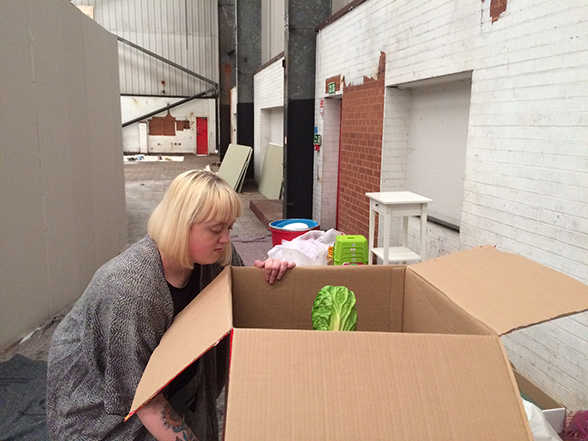
“Unpacked from their crates, the items that Ramin Haerizadeh, Rokni Haerizadeh & Hesam Rahmanian smuggled from their villa in Dubai seemed like nothing more than just objects,” Dominic reflects. “Yet, once assembled by the artists in particular combinations (such as a cabbage, fish and plastic garden-chair) they quickly took on an animated, character-like form. Furthermore, each of the characters – called ‘submersibles’ by the artists – are clearly related, yet unique. Experienced on different occasions across the festival’s numerous sites, they seem to form part of an interconnected world all of their own: sometimes playful, sometimes malignant.” This world also extends to the short films on show at Open Eye Gallery and Cains Brewery, where the ‘submersibles’ are performed by the artists themselves.
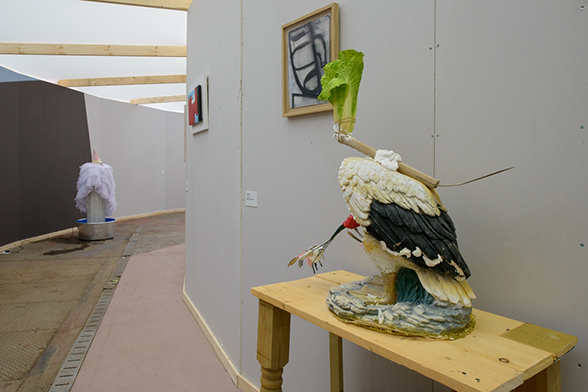
Ramin Haerizadeh, Rokni Haerizadeh and Hesam Rahmanian's sculptures at Cains Brewery. Photo: Mark McNulty
Elsewhere, Sahej Rahal's clay sculptures at Cains Brewery and Tate Liverpool also have a distinctly anthropomorphic appearance, “like ancient characters emerging out of a primeval swamp,” Willsdon describes. “They’re on the cusp of collapsing into nothing more than just ‘matter’, yet you get the sense they could quite easily reach out grab you if you stepped too close.”
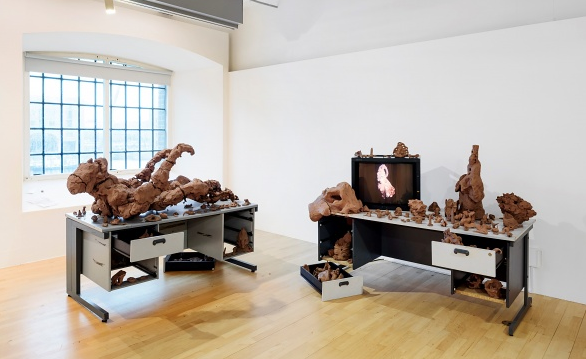
L-R Sahej Rahal, UNDERGOD, 2016 and Saras, 2012. Tate Liverpool. Photo: Roger Sinek
Fictional characters appear elsewhere throughout the festival. “Think of Lu Pingyuan's ‘foreigner’ emerging from a freshwater lake in a village in China, whose story you can read at Hondo Chinese Supermarket; Mariana Castillo Deball's time-traveller who can jump between 9th of Julys throughout history; or Sahej Rahal’s ‘forest that is also a hermaphrodite narrator’ in the exhibition’s accompanying book” Willsdon adds. “Similarly, Hondo Chinese Supermarket’s resident cat Banjo inspired the Biennial 2016 Children’s Guide and is at the ready to take younger visitors on a journey across the city.”
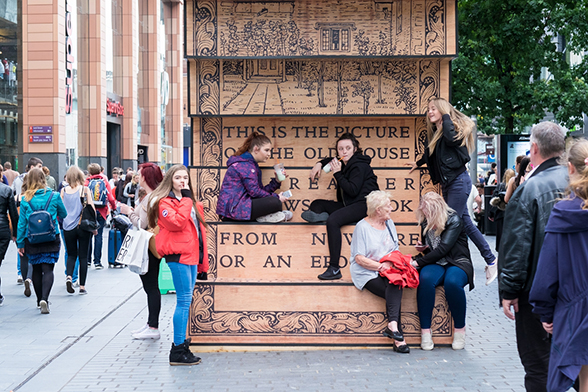
Mariana Castillo Deball, To-day 9th of July 2016, 2016. Liverpool ONE. Photo: Mark McNulty
Computer Pixels Become Other Worlds
Not only is the festival organised around the idea of stories and fictional worlds, but many of the works demand the audience to enter into, and become part of, that world. The Minecraft Infinity Project invites anyone to step onto the Minecraft map and collaborate in building the largest ever virtual sculpture. Indeed, the project’s goal is to build a ‘living portrait’ of Liverpool Biennial 2016, in which users render their own version of the exhibition and artworks on show, “giving them a second, digital incarnation,” as Willsdon terms it.
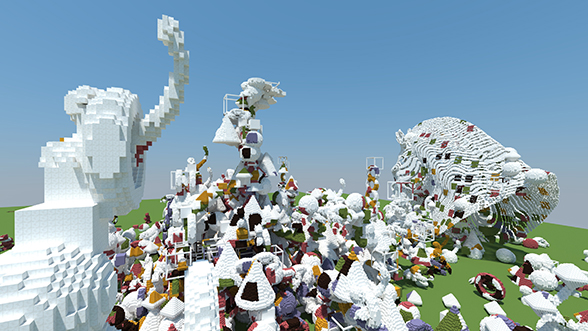
“Sticking with the digital for a moment, there’s also Shiba Emissary, Ian Cheng’s virtual dog that verbally commands viewers to follow her around the exhibition at Cains Brewery,” he continues. “In the mixed reality simulation, Emissary Forks For You, the traditional power dynamic between human and animals, and humans and technology, is reversed as the viewer assumes the role of pet. It’s only by entering into the game, full heartedly, that visitors can experience this.”

Ian Cheng, Emissary Forks For You, 2015. Cains Brewery. Photo: Mark McNulty
This responsibility on the viewer to bring the artworks to life extends to many other areas of the festival, such as Audrey Cottin’s Flour Tables nearby. “This piece demands the audience’s involvement to generate stories. Without that, it’s just a pile of flour on the table. Similarly, Lu Pingyuan’s The Artist Made of Paper, also at Cains Brewery, requires people to use the origami technique to fold the story’s character (the artist) into being.”
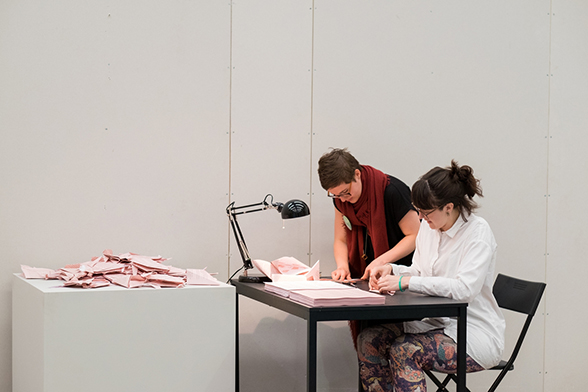
Lu Pingyuan, The Artist Made of Paper, 2016. Cains Brewery. Photo: Mark McNulty
Buildings and Spaces
Buildings and spaces have also been brought to life for Biennial 2016. After being closed for several years, Liverpool’s iconic ABC Cinema re-opened its doors for the festival, reawakening memories among many of those who visited it in the past. “But the lighting of the space also plays an important role,” Willsdon adds, “causing it to morph and evolve continually. When the lights are off, it’s a film exhibition; when they’re on, it’s a sculpture exhibition.” Cast in darkness, we are at the peril of the space, waiting for its next breath of light.
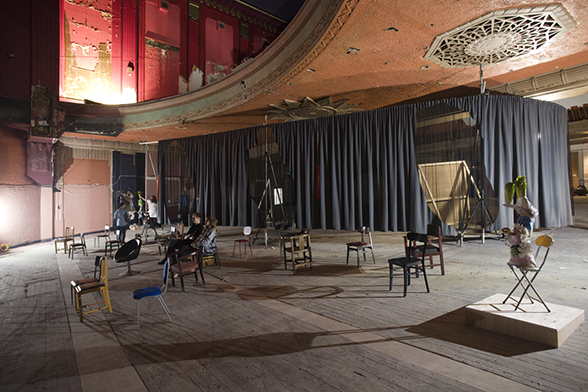
Exhibition view at ABC Cinema. Photo: Jerry Hardman-Jones
Liverpool Biennial 2016 is free to visit and open daily until 16 October.
Liverpool Biennial
55 New Bird Street
Liverpool L1 0BW
- T +44 (0)151 709 7444
- info@biennial.com
Liverpool Biennial is funded by
Founding Supporter
James Moores